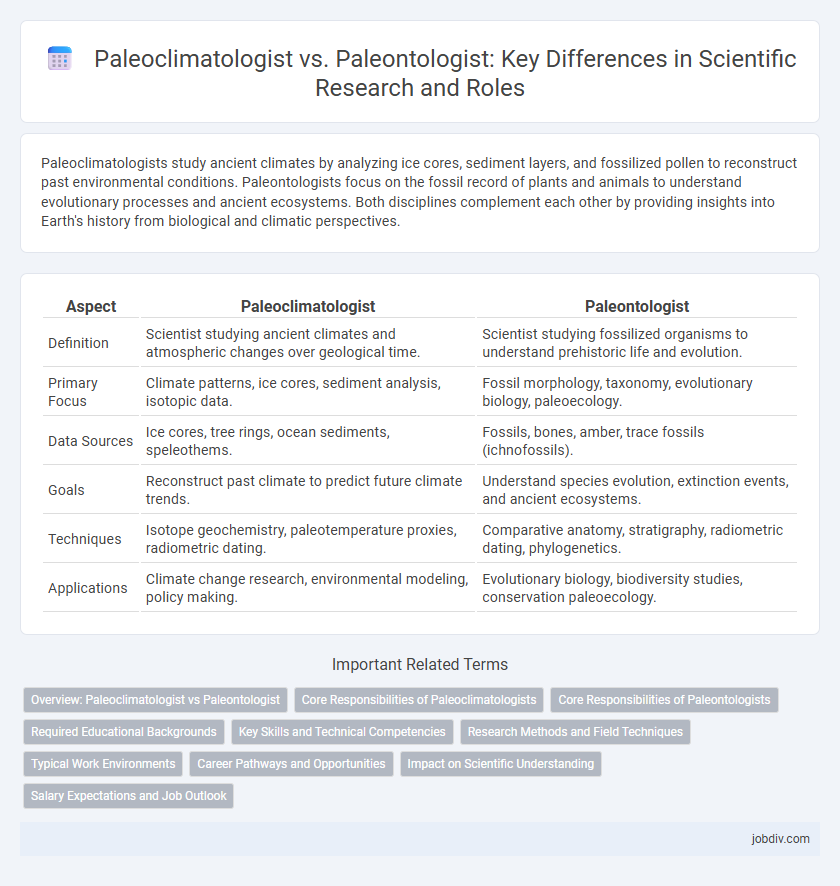Paleoclimatologists study ancient climates by analyzing ice cores, sediment layers, and fossilized pollen to reconstruct past environmental conditions. Paleontologists focus on the fossil record of plants and animals to understand evolutionary processes and ancient ecosystems. Both disciplines complement each other by providing insights into Earth's history from biological and climatic perspectives.
Table of Comparison
| Aspect | Paleoclimatologist | Paleontologist |
|---|---|---|
| Definition | Scientist studying ancient climates and atmospheric changes over geological time. | Scientist studying fossilized organisms to understand prehistoric life and evolution. |
| Primary Focus | Climate patterns, ice cores, sediment analysis, isotopic data. | Fossil morphology, taxonomy, evolutionary biology, paleoecology. |
| Data Sources | Ice cores, tree rings, ocean sediments, speleothems. | Fossils, bones, amber, trace fossils (ichnofossils). |
| Goals | Reconstruct past climate to predict future climate trends. | Understand species evolution, extinction events, and ancient ecosystems. |
| Techniques | Isotope geochemistry, paleotemperature proxies, radiometric dating. | Comparative anatomy, stratigraphy, radiometric dating, phylogenetics. |
| Applications | Climate change research, environmental modeling, policy making. | Evolutionary biology, biodiversity studies, conservation paleoecology. |
Overview: Paleoclimatologist vs Paleontologist
Paleoclimatologists analyze ancient climate patterns using data from ice cores, tree rings, and sediment layers to understand Earth's climatic history and predict future climate trends. Paleontologists study fossilized remains of plants and animals to reconstruct past ecosystems and evolutionary processes. While both fields investigate Earth's past, paleoclimatology emphasizes climate systems, and paleontology centers on biological history and organismal development.
Core Responsibilities of Paleoclimatologists
Paleoclimatologists specialize in reconstructing past climate conditions by analyzing ice cores, sediment layers, and fossilized pollen to understand Earth's historical climate variability. Their core responsibilities include interpreting proxy data to model ancient atmospheric composition, temperature fluctuations, and ocean circulation patterns. These insights help predict future climate trends and assess anthropogenic impacts on global systems.
Core Responsibilities of Paleontologists
Paleontologists specialize in studying fossils to understand the history of life on Earth, focusing on the identification, classification, and analysis of ancient organisms. Their core responsibilities include excavating fossil remains, conducting field surveys, and interpreting paleobiological data to reconstruct past ecosystems and evolutionary patterns. Unlike paleoclimatologists, who analyze climate records from ice cores or sediment layers, paleontologists concentrate on biological evidence to decipher the interaction between organisms and their environments over geological time.
Required Educational Backgrounds
Paleoclimatologists typically require advanced degrees in earth sciences, geology, or atmospheric sciences, with specialized training in climate modeling and data analysis. Paleontologists often hold degrees in biology, paleontology, or geology, emphasizing fossil identification, evolutionary biology, and sedimentology. Both fields demand strong foundations in scientific research methods, but paleoclimatology leans more toward understanding past climates through geochemical proxies and climate systems, while paleontology focuses primarily on the study of ancient life through fossil records.
Key Skills and Technical Competencies
Paleoclimatologists possess expertise in analyzing climate proxies such as ice cores, sediment layers, and tree rings to reconstruct past climate conditions using specialized techniques like isotope geochemistry and climate modeling. Paleontologists focus on fossil identification, taxonomy, and evolutionary biology, employing skills in field excavation, specimen preparation, and morphological analysis to study ancient life forms. Both disciplines require proficiency in data interpretation, statistical analysis, and Geographic Information Systems (GIS) to synthesize findings related to Earth's historical ecosystems and climatic changes.
Research Methods and Field Techniques
Paleoclimatologists analyze ice cores, sediment layers, and isotopic data to reconstruct past climate conditions, using tools such as mass spectrometers and climate modeling software. Paleontologists focus on excavating and studying fossilized bones, tracks, and plant remains through techniques like stratigraphic analysis and radiometric dating to understand ancient life forms. Both disciplines employ field excavation, but paleoclimatology emphasizes climate proxies, while paleontology prioritizes fossil morphology and taxonomy.
Typical Work Environments
Paleoclimatologists typically conduct research in university laboratories, climate research centers, and remote field locations to analyze geological samples and climate proxies such as ice cores and sediment layers. Paleontologists often work in natural history museums, fossil excavation sites, and academic institutions, focusing on uncovering and studying fossilized remains of ancient organisms. Both professions require access to specialized analytical instruments and collaborative environments for interpreting Earth's historical data.
Career Pathways and Opportunities
Paleoclimatologists specialize in studying past climate conditions using ice cores, sediment layers, and fossilized pollen, often working in academic research, environmental consulting, or governmental climate agencies. Paleontologists focus on fossilized remains of plants and animals to understand evolutionary history, commonly employed in museums, universities, or natural resource industries. Career pathways for paleoclimatologists tend to emphasize climate modeling and geochemical analysis, while paleontologists pursue roles in field excavation, taxonomy, and paleobiology research.
Impact on Scientific Understanding
Paleoclimatologists analyze ancient climate data through ice cores, sediment records, and isotopic evidence, offering critical insights into historical climate patterns and their influence on Earth's systems. Paleontologists study fossilized organisms, revealing evolutionary processes and biodiversity shifts across geological time. Together, their research deepens scientific understanding of how climatic changes have driven biological evolution and ecosystem transformations.
Salary Expectations and Job Outlook
Paleoclimatologists typically earn higher salaries than paleontologists due to the specialized nature of climate data analysis and demand in environmental research sectors, with median salaries ranging from $70,000 to $110,000 annually. Job outlook for paleoclimatologists is projected to grow by 8% over the next decade, driven by increased focus on climate change studies and environmental policy. Paleontologists, earning median salaries between $60,000 and $90,000, face a steadier job outlook of about 5% growth, primarily in academic research, museums, and geological surveys.
Paleoclimatologist vs Paleontologist Infographic

 jobdiv.com
jobdiv.com